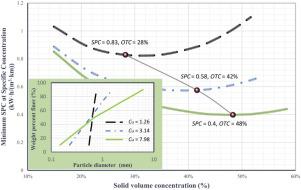Particuology ( IF 4.1 ) Pub Date : 2021-09-01 , DOI: 10.1016/j.partic.2021.08.004 Mingzhi Li 1 , Yanping He 1, 2 , Ruhong Jiang 1, 2 , Ji Zhang 3 , Hongsheng Zhang 4 , Weihuang Liu 1 , Yadong Liu 1

|
Slurry pipeline transport is widely used in several industrial processes. Calculating the specific power consumption (SPC) and determining the best working conditions are important for the design and operation of transportation systems. Based on the Shanghai Jiao Tong University high-concentration multi-sized slurry pressure drop (SJTU-HMSPD) pipeline-resistance-calculation model, the SJTU-SPC model for calculating the power required to transport a unit volume of solid materials over a unit pipeline length is established for a slurry transport system. The said system demonstrates a uniformity coefficient in the 1.26–7.98 range, median particle size of 0.075–4 mm, particle volume concentration of 10–60%, and pipeline diameter of 0.203–0.8 m. The results obtained were successfully verified against existing experimental data. The influence of parameters, such as particle-gradation uniformity coefficient, median particle size, pipe diameter, and particle volume concentration, on the SPC were analysed. The results revealed that the greater is the uniformity coefficient, the smaller is the minimum specific energy consumption and the larger the optimal transport concentration for a constant, median particle size slurry. As observed, the optimal transport concentration for broad-graded sand equalled approximately 48%. These results supplement the conclusions of existing research, indicating that the optimal transport concentration is approximately 30% and provides theoretical support for high concentration transportation of broad graded slurry.
中文翻译:

泥浆管道输送系统最小单位能耗及最佳输送浓度分析
泥浆管道输送广泛用于多种工业过程。计算比功耗 (SPC) 并确定最佳工作条件对于运输系统的设计和运行非常重要。基于上海交通大学高浓度多尺寸泥浆压降(SJTU-HMSPD)管道阻力计算模型,SJTU-SPC模型计算单位管道输送单位体积固体物料所需功率长度是为泥浆输送系统建立的。该系统的均匀系数在 1.26-7.98 范围内,中值粒径为 0.075-4 mm,颗粒体积浓度为 10-60%,管道直径为 0.203-0.8 m。获得的结果成功地验证了现有的实验数据。分析了颗粒级配均匀系数、中值粒径、管径和颗粒体积浓度等参数对SPC的影响。结果表明,均匀系数越大,最小比能量消耗越小,恒定的中值粒径浆料的最佳传输浓度越大。正如所观察到的,宽级配砂的最佳输送浓度约为 48%。这些结果补充了现有研究的结论,表明最佳输运浓度约为30%,为宽级配浆体的高浓度输运提供了理论支持。对 SPC 进行了分析。结果表明,均匀系数越大,最小比能量消耗越小,恒定的中值粒径浆料的最佳传输浓度越大。正如所观察到的,宽级配砂的最佳输送浓度约为 48%。这些结果补充了现有研究的结论,表明最佳输运浓度约为30%,为宽级配浆体的高浓度输运提供了理论支持。对 SPC 进行了分析。结果表明,均匀系数越大,最小比能量消耗越小,恒定的中值粒径浆料的最佳传输浓度越大。正如所观察到的,宽级配砂的最佳输送浓度约为 48%。这些结果补充了现有研究的结论,表明最佳输运浓度约为30%,为宽级配浆体的高浓度输运提供了理论支持。宽级配砂的最佳输送浓度约为 48%。这些结果补充了现有研究的结论,表明最佳输运浓度约为30%,为宽级配浆体的高浓度输运提供了理论支持。宽级配砂的最佳输送浓度约为 48%。这些结果补充了现有研究的结论,表明最佳输运浓度约为30%,为宽级配浆体的高浓度输运提供了理论支持。











































 京公网安备 11010802027423号
京公网安备 11010802027423号